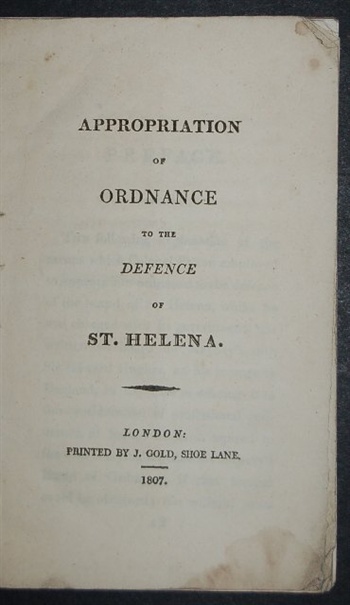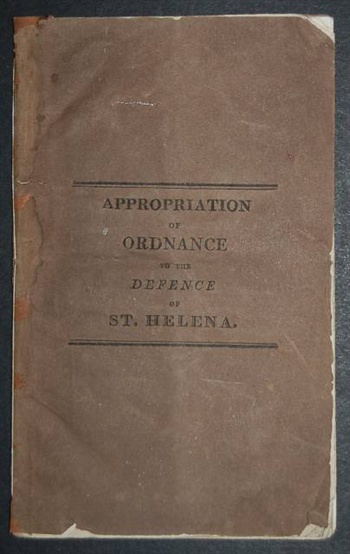Book Details
SAINT HELENA.. Appropriation of Ordnance to the Defence of St. Helena.1807
London: Printed by J. Gold, Shoe Lane, First edition, 12mo, iv, [5]-27, [1]pp., original printed wrappers (a little chipped), stitched as issued. This little pamphlet gives a detailed explanation of the defences that Colonel Patton, governor of St. Helena, took to improve the island from attack. The island has shear cliffs on all sides which rise from 400 to 1,000 feet, and are inaccessible to an enemy from the sea. Guns and Canons were placed at the top of these heights and were able to fire directly down on any debarking troops and command that approach by sea. Patton had the advantage of employing the invention of Colonel Shrapnell's exploding 'round case shot' with fuses to explode them over the enemy. These are the shells that soon earned the name shrapnel. "Every piece of ordnance intended for the defence of the interior of St. Helena, whether mounted upon garrison or field carriages,.... ought to depress as far as fifty degrees.... and the landing places in many situations requires this depression...." Patton devised traversing and horizontal platforms for garrison guns and field ordnance at strategic elevated positions on the cliffs. The perpendicular height of every maritime post from sea level was measured and a table formed for each of the stations, that gave in yards the distances which corresponded to the degrees and minutes of the angle of depression. Of these tables three were completed, one for Ladderhill, one for Rupert's Point, and one for Goat-pound Ridge. The advantages derived from the platforms mostly depended on high situations, and therefore were most exclusively appropriated to St. Helena. **** The notes for this book were written on board his Majesty's ship Sir Edward Hughes, on Patton's homeward journey to England. He hoped that "his suggestions might possibly be found of some advantage to the service of his sovereign..... [and] for these purposes he brought models with him of the carriages and platforms which he had adopted at St. Helena."—Preface. Provenance: From the library of Quentin Keynes. Not on COPAC or OCLC.
Stock #34685



